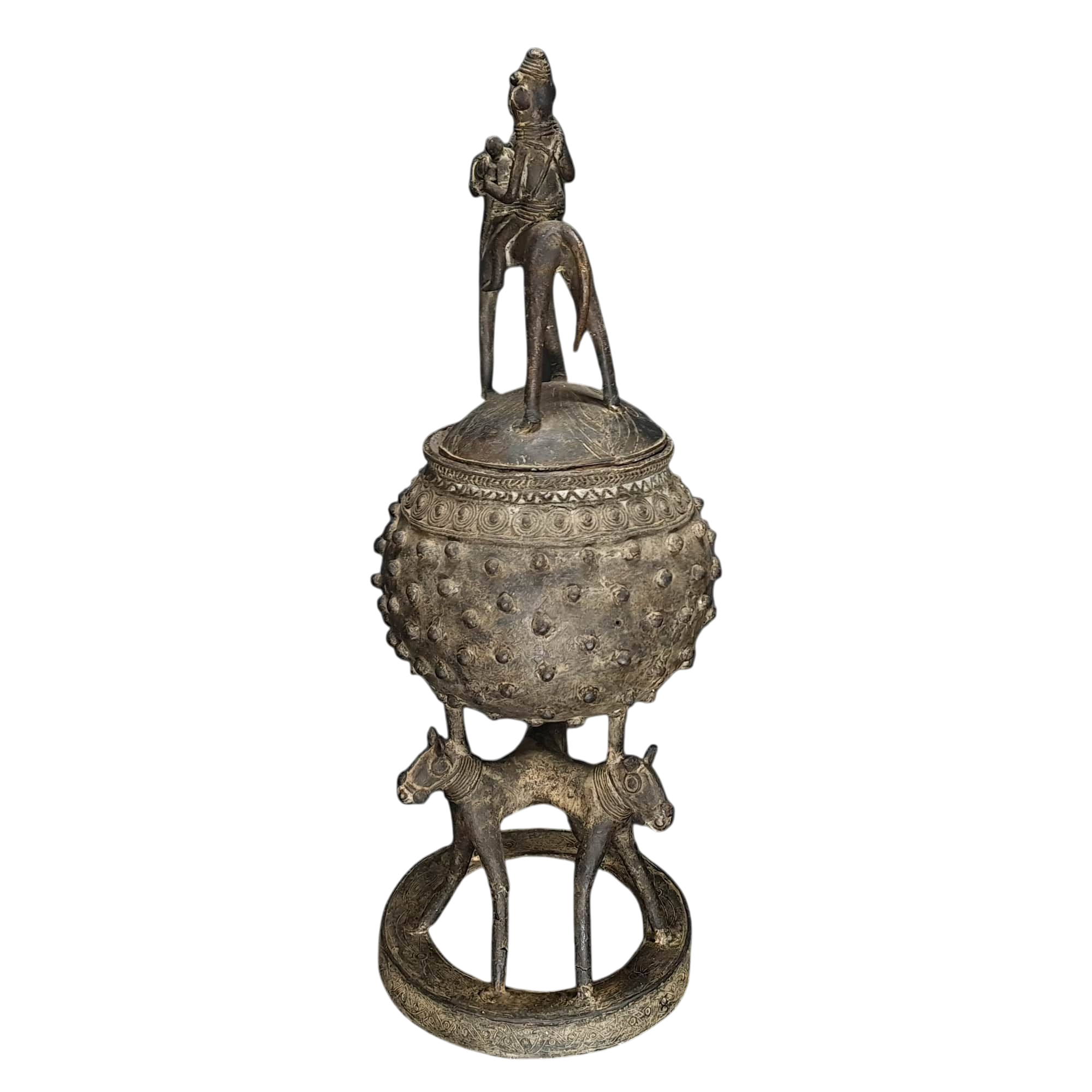Dimensions and Weight
Weight: 5.565 kg
Height: 59 cm
Width: 22.5 cm
Historical and Cultural Context
Kingdom of Benin: The Kingdom of Benin, founded around the 11th century, is renowned for its artistic production in bronze and brass, including plaques, heads, and figurines. The kingdom reached its peak between the 15th and 17th centuries.
Royal Court Art: The bronze objects, including the pots with riders, were primarily produced by artisan guilds of the royal court in Edo (formerly Benin City). These items were commissioned by the Oba (king) and the nobility.
Description and Characteristics
Materials and Techniques: The pots are made of bronze or brass using the lost-wax casting method. This technique allows for the creation of detailed and precise works, known for their durability and brilliance.
Design: The pots often feature a wide base with a slender body, topped by the figure of a rider. The rider is depicted in a realistic manner, often in armor and holding weapons or royal insignia.
Details and Symbols: The sculptures of the riders are richly detailed, showcasing distinctive features such as elaborate hairstyles, clothing, scarification, and adornments. The horses are also adorned with harnesses and decorations.
Symbolic Significance
Power and Authority: The rider symbolizes the power and authority of the Oba and the nobility. Horses, introduced to West Africa by Arab and North African traders, were symbols of prestige and military power.
Spiritual Protection: The pots with riders could also serve as protective talismans, invoking the protection of ancestors and deities over the community and its leaders.
Ritual and Ceremony: These objects were used in various court rituals and ceremonies, including rites of passage, royal celebrations, and ancestor commemorations.
Artistic and Historical Importance
Masterpiece of Benin Art: The bronze pots with riders are considered masterpieces of Benin art. They illustrate the technical mastery and refined aesthetics of Benin artisans.
Preservation and Museums: Many of these pieces are now found in museums around the world, including the British Museum, the Metropolitan Museum of Art, and the Musée du Quai Branly. They are highly valued by collectors and art historians.
Colonial Plunder: Many of these works were looted by British forces during the punitive expedition of 1897. This plunder led to the worldwide dispersal of Benin’s artistic treasures.
Debates on Restitution
Restitution of old Artworks: There is a growing movement for the restitution of looted artifacts to their African countries of origin. The Kingdom of Benin, in particular, is at the center of these discussions, with calls to return these art objects to their original locations to preserve cultural and historical heritage.
Recent Initiatives: Recent initiatives have seen some museums and international institutions begin returning old artworks to Nigeria, recognizing their cultural and historical importance.
Conclusion
In summary, the Benin bronze pots with a rider are significant works of art that testify to the cultural and artistic richness of the Kingdom of Benin. They symbolize royal power and authority while serving as examples of the sophisticated craftsmanship of Benin artisans. Their complex history, marked by colonization and debates on restitution, adds an additional dimension to their cultural and historical importance.
Provenance
Private collection ZAMBELLI/BRUGNACCHI, assembled between 1990 and 2023.
Transferred to the Spirit Land of Africa Gallery in 2023.
600.00 €



